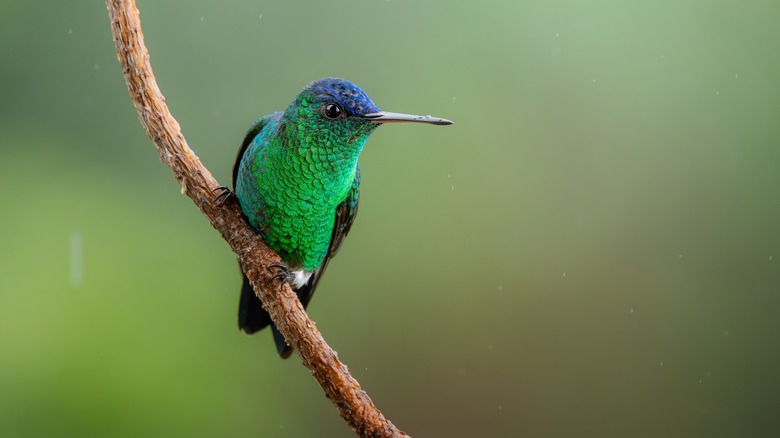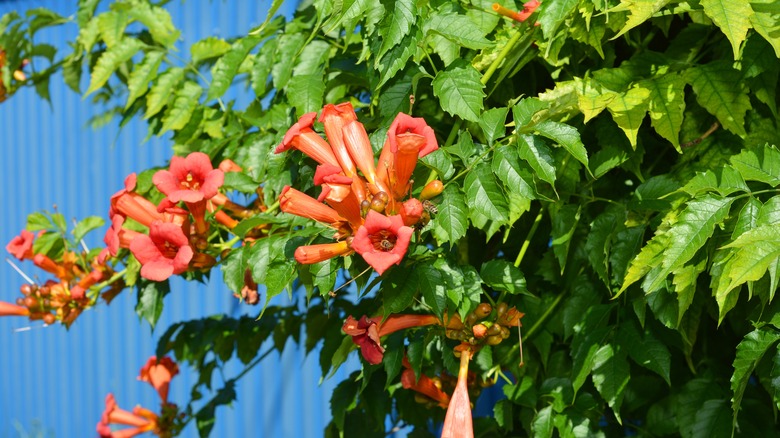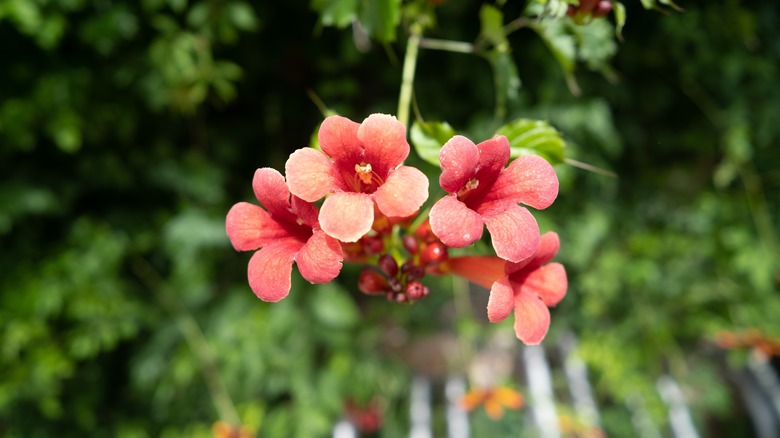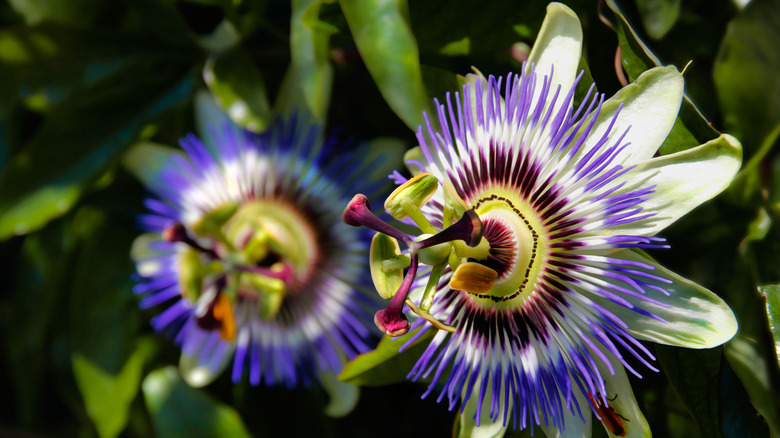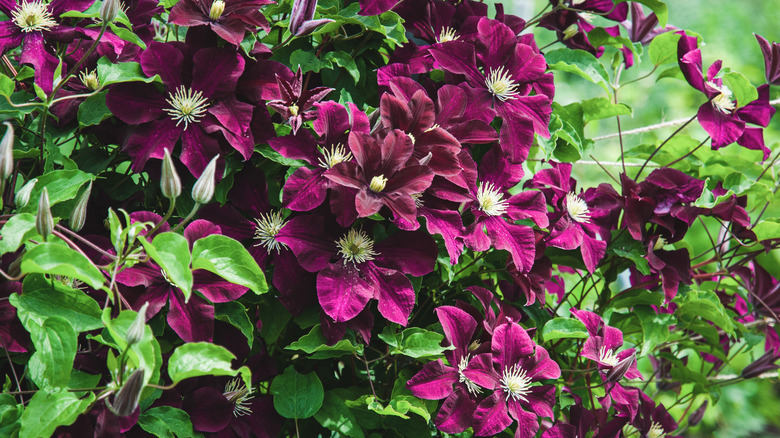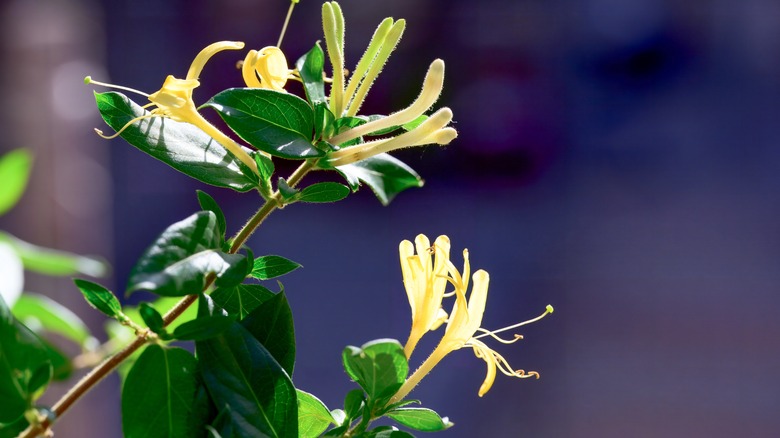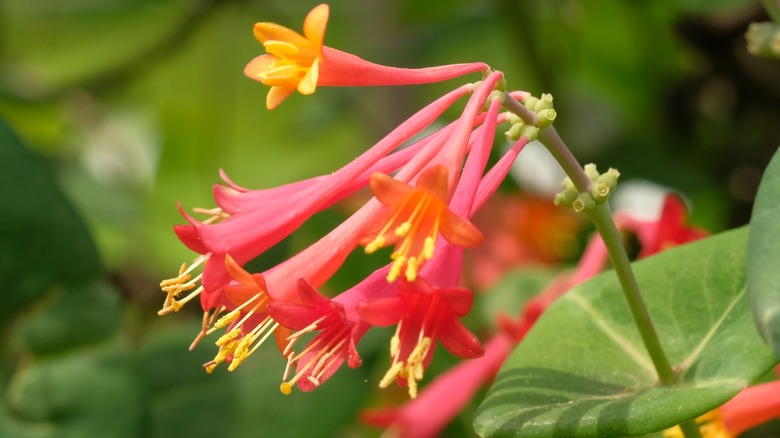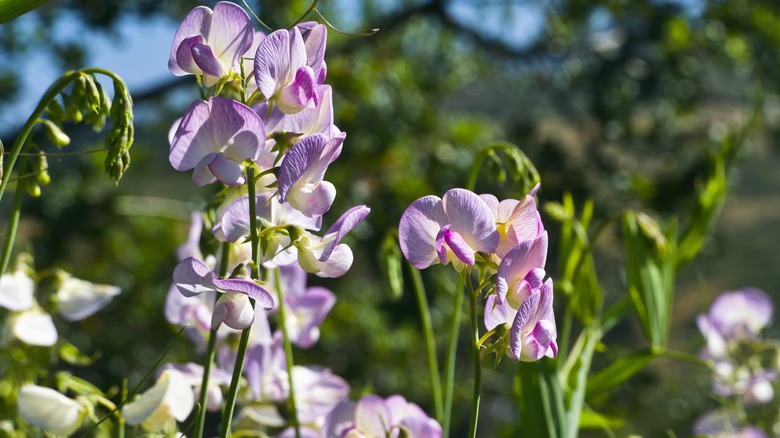7 Flowering Vines That Will Keep Hummingbirds Coming Back To Your Yard
Hummingbirds are some of the world's tiniest birds, yet they can bring endless delight as they flit about in your yard or garden. As Chilean poet Pablo Neruda once wrote, these extraordinary creatures "spin like light within light, air in air," their gleaming wings a "tiny living lightning flash." The sight of a hummingbird's jewel-like feathers shimmering through the garden means that they're hard at work at pollination, transferring pollen from one flower to another as they indulge in the blooms' nectar. If you want to encourage pollination and entice hummingbirds to your home, planting non-invasive flowering vines such as trumpet creeper and cross vine will have various hummingbird species flocking to your yard.
Feeders for hummingbirds are often sold in shades of red, because a hummers' vision is keenly tuned to notice shades of orange, pink, and red, however, they will drink nectar from a variety of flowers. The speedy little birds particularly enjoy tubular flowers, because their long, slender shape is an ideal fit for a hummingbird's beak and tongue. If you desire a bustling hummingbird habitat in your yard, here are a few native, non-invasive flowering vines to consider planting.
Trumpet creeper's nectar is music to a hummingbirds' ears
The musical-sounding flower trumpet creeper (Campsis radicans) often attracts ruby-throated hummingbirds to its tubular flowers, which offer 10 times as much nectar as other plants. Easily grown in nearly any soil that is well-draining, it's native throughout most of the United States, especially within USDA hardiness zones 4 to 10. If it grows out of control, consider trying it in as a container instead. One note of caution is trumpet creeper is mildly toxic, so you should wear gloves when handling, and keep out of reach of children and pets.
The tall cross vine plant draws attention and hummingbirds galore
Bell-shaped orange-red blooms make the cross vine (Bignonia capreolata) a beautiful blooming plant that attracts hummingbirds to your yard. With its ability to grow to a spectacular 50 feet, it dazzles in any garden and features a powerful mocha fragrance. The semi-evergreen cross vine looks similar to trumpet creeper, but begins to bloom in the spring, compared to the creeper's mid-summer to early fall blooms. This native plant prefers low to medium watering with full sun to partial shade in various moist, well-drained soils.
Watch hummingbirds pop up to the purple passion flower
Also known as the maypop for its fruits that pop when they're crushed, the violet hues of the purple passionflower (Passiflora incarnata) set it apart from other vine plants, creating a stunning showpiece for your garden. It's a fast-growing perennial that will turn your yard into a pollinator haven as it climbs up to 25 feet. Fruit birds, bumble bees, and hummingbirds savor the purple passionflower's offerings as it offers nutrients and shelter. Native through the Southeast, it grows naturally along roadsides and riverbanks. When growing, expect blooms from early spring to late fall.
Clematis bursts provide nectar and shelter to hummingbirds
More than just a source of nectar, clematis (Clematis) is prized by hummingbirds for the rich shelter it offers the birds with its dense mats. With flowers varied in shape, the plant family is vast with over 300 species. Most prefer slightly acidic to neutral soil with the Southeastern species most readily adaptable. This plant prefers to have its flowers in the sun and its roots in the shade. Most species of clematis do well in loamy, well-draining soil. Slow to start, clematis grows well after it establishes roots.
Hummingbirds will flock to the yellow honeysuckle in your yard
Yellow honeysuckle (Lonicera flava) boasts a pleasing scent as it climbs up your trellis or other structures. If you have an area slightly shaded, it may be perfect for yellow honeysuckle, as it prefers partial shade. In addition to attracting hummingbirds with a sweet nectar, yellow honeysuckle's berries attract birds to gardens in the Southeastern region. If growing, give its stems support and room to spread. Don't confuse it with the invasive Japanese honeysuckle (Lonicera japonica), which can smother other plants.
Hummingbirds are so sweet on coral honeysuckle
Coral honeysuckle (Lonicera sempervirens) has many names, including hummingbird honeysuckle, woodbine, and trumpet honeysuckle. It's also a known hummingbird magnet with its dramatic trumpet-shaped red and yellow flowers. At first, this semi-evergreen needs support to begin its upward climb at first, but can eventually grow up to 20-feet long. With good light and drainage, it can be quite easy to grow, with its flowering time in spring. Native throughout the Southeastern United States, it does well in coastal areas but can be subject to powdery mildew in humid climates.
Hummingbirds will give everlasting peas a chance
The everlasting pea (Lathyrus latifolius) , or perennial sweet pea, is a stunner that attracts hummingbirds and butterflies with its summer blooms. Everlasting pea blooms in pink and white flowers, but cultivars also exist for blue, purple, and gold flowers. Often present in parks or alongside roadsides, it can quickly climb fences or a trellis, growing 10 feet high. Growing everlasting pea requires well-drained soil and adequate sun, preferably full sun for six hours. However, Washington State and other states have it on their monitor/watch or control list, so check on any local growing notes before planting.
